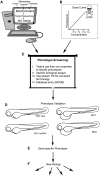Lessons from morpholino-based screening in zebrafish
- PMID: 21746693
- PMCID: PMC3144740
- DOI: 10.1093/bfgp/elr021
Lessons from morpholino-based screening in zebrafish
Abstract
Morpholino oligonucleotides (MOs) are an effective, gene-specific antisense knockdown technology used in many model systems. Here we describe the application of MOs in zebrafish (Danio rerio) for in vivo functional characterization of gene activity. We summarize our screening experience beginning with gene target selection. We then discuss screening parameter considerations and data and database management. Finally, we emphasize the importance of off-target effect management and thorough downstream phenotypic validation. We discuss current morpholino limitations, including reduced stability when stored in aqueous solution. Advances in MO technology now provide a measure of spatiotemporal control over MO activity, presenting the opportunity for incorporating more finely tuned analyses into MO-based screening. Therefore, with careful management, MOs remain a valuable tool for discovery screening as well as individual gene knockdown analysis.
Figures


Similar articles
-
Quantitative assessment of the knockdown efficiency of morpholino antisense oligonucleotides in zebrafish embryos using a luciferase assay.Genesis. 2008 Jan;46(1):1-7. doi: 10.1002/dvg.20361. Genesis. 2008. PMID: 18196596
-
A PATO-compliant zebrafish screening database (MODB): management of morpholino knockdown screen information.BMC Bioinformatics. 2008 Jan 7;9:7. doi: 10.1186/1471-2105-9-7. BMC Bioinformatics. 2008. PMID: 18179718 Free PMC article.
-
Design and Microinjection of Morpholino Antisense Oligonucleotides and mRNA into Zebrafish Embryos to Elucidate Specific Gene Function in Heart Development.J Vis Exp. 2022 Aug 9;(186):10.3791/63324. doi: 10.3791/63324. J Vis Exp. 2022. PMID: 36036621 Free PMC article.
-
Functional genomics tools for the analysis of zebrafish pigment.Pigment Cell Res. 2004 Oct;17(5):461-70. doi: 10.1111/j.1600-0749.2004.00189.x. Pigment Cell Res. 2004. PMID: 15357832 Review.
-
Morpholinos: Antisense and Sensibility.Dev Cell. 2015 Oct 26;35(2):145-9. doi: 10.1016/j.devcel.2015.09.017. Dev Cell. 2015. PMID: 26506304 Review.
Cited by
-
Analysis of Zebrafish Kidney Development with Time-lapse Imaging Using a Dissecting Microscope Equipped for Optical Sectioning.J Vis Exp. 2016 Apr 7;(110):e53921. doi: 10.3791/53921. J Vis Exp. 2016. PMID: 27078207 Free PMC article.
-
The Contribution of the Zebrafish Model to the Understanding of Polycomb Repression in Vertebrates.Int J Mol Sci. 2023 Jan 24;24(3):2322. doi: 10.3390/ijms24032322. Int J Mol Sci. 2023. PMID: 36768643 Free PMC article. Review.
-
Utility of the Zebrafish Model for Studying Neuronal and Behavioral Disturbances Induced by Embryonic Exposure to Alcohol, Nicotine, and Cannabis.Cells. 2023 Oct 23;12(20):2505. doi: 10.3390/cells12202505. Cells. 2023. PMID: 37887349 Free PMC article. Review.
-
The homologous recombination component EEPD1 is required for genome stability in response to developmental stress of vertebrate embryogenesis.Cell Cycle. 2016;15(7):957-62. doi: 10.1080/15384101.2016.1151585. Cell Cycle. 2016. PMID: 26900729 Free PMC article.
-
Proprotein convertase subtilisin/kexin type 7 (PCSK7) is essential for the zebrafish development and bioavailability of transforming growth factor β1a (TGFβ1a).J Biol Chem. 2013 Dec 20;288(51):36610-23. doi: 10.1074/jbc.M113.453183. Epub 2013 Oct 31. J Biol Chem. 2013. PMID: 24178295 Free PMC article.
References
-
- Barstead R. Genome-wide RNAi. Curr Opin Chem Biol. 2001;5:63–6. - PubMed
-
- Lum L, Yao S, Mozer B, et al. Identification of Hedgehog pathway components by RNAi in Drosophila cultured cells. Science. 2003;299:2039–45. - PubMed
-
- Eisen JS, Smith JC. Controlling morpholino experiments: don’t stop making antisense. Development. 2008;135:1735–43. - PubMed
-
- Summerton J, Weller D. Morpholino antisense oligomers: design, preparation, and properties. Antisense Nucleic Acid Drug Dev. 1997;7:187–95. - PubMed
Publication types
MeSH terms
Substances
Grants and funding
LinkOut - more resources
Full Text Sources
Other Literature Sources
Medical

